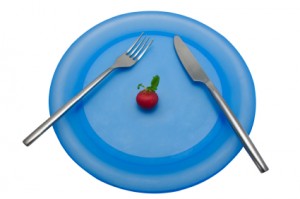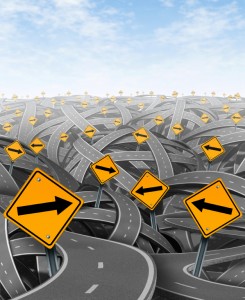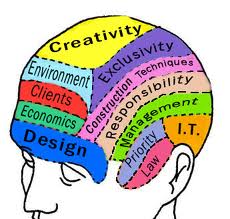Diets Make You Dumb

Eat some bandwidth.
Several weeks ago, I wrote “Does Poverty Cause Poverty?” based on a research report in Science magazine. The idea is simple but provocative: the shortage of money causes additional cognitive load. Worrying about how to make ends meet takes cognitive bandwidth. You have less bandwidth available to focus your mental faculties and make smart decisions. The authors compare it to trying to make informed decisions after going a night without sleep. Thus, poor people and poor decisions go hand in hand. Poverty causes poverty.
I’ve now discovered that the authors, Sendhil Mullainathan and Eldar Shafir, have written an entire book on the subject: Scarcity: Why Having Too Little Means So Much. It’s not just about poverty but about scarcity of all kinds.
When you’re faced with scarcity – whether it’s money, time, food, influence, or space – you spend some amount of your cognitive bandwidth figuring out how to deal with the issue. If you don’t have enough “pull” in the office, for instance, you’ll need to spend some amount of time devising a strategy. You may study the arts of persuasion, or form alliances, or give generously to the boss’s favorite charity. While you’re doing any one of these things, you’re not increasing your influence. You’re merely spending precious cognitive resources plotting how to increase your influence.
I’ve sensed this when I have too many things to do and not enough time to do them. (Sound familiar?) I used to agonize over which task to do first. What’s the highest priority? What should I do first? What should I do second? I might even make up a list. Then it dawned on me that, while I was doing all these things, I wasn’t accomplishing any of my priorities. I was using cognitive resources planning rather than doing. Now I just flip a coin and get to work.
Perhaps my favorite example is dieting. Generally, dieting to lose weight requires reducing your food intake. You’re creating scarcity. You’re constantly asking yourself, “If I eat this, can I eat that?” If you backslide a bit, you’ll ask yourself, “Now why did I do that?”
Instead of eating food, you’re eating bandwidth. You only have so much cognitive bandwidth and you’re using some of it to calculate calories, make trade-offs, and perhaps even chastising yourself. You have less bandwidth left over to make wise decisions.
Mullainathan also reports that lack of bandwidth can hamper your resolve to diet. In an experiment, dieters were divided into two groups. One group was asked to remember a seven-digit number, the other group only a two-digit number. They were then offered a choice between fruit salad and a cake. The first group – with less bandwidth – was 50% more likely to choose cake than the second group.
I suppose the moral is to preserve your bandwidth. And, in fact, if you don’t have a lot of bandwidth you don’t need to read all of Scarcity. You can preserve bandwidth by reading a nice summary here.
Creativity Templates – 1
 I’m pretty good at leading brainstorming sessions. I can get people involved, gin up the excitement, and lead a rollicking session. They’re a lot of fun. But are they productive?
I’m pretty good at leading brainstorming sessions. I can get people involved, gin up the excitement, and lead a rollicking session. They’re a lot of fun. But are they productive?
Traditional brainstorming techniques derive from the concepts of free association and divergent thinking which, as Wikipedia notes, “… is a thought process used to generate creative ideas by exploring many possible solutions.” By exploring many different options, we may come up with something useful.
At the very least, it sounds inefficient – like the random programming of computers. Indeed, I rarely find useful ideas in traditional brainstorming sessions. A session may generate a lot of ideas but many of them of them are either trite or just plain silly.
So I was pleased to find a set of “creativity templates” in an article published in 1999 by Jacob Goldenburg, David Mazursky, and Sorin Solomon of the Jerusalem Scool of Business Administration.
The article investigates high quality advertisements. Do they have common features (templates) and can we use those commonalities to create better ads? The authors studied 200 award-winning ads and identified six basic templates (and several sub-templates). The researchers then compared the award-winning ads (let’s call it Group 1) to two other groups:
- Group 2 — 200 ads that had been selected for The One Show Album, a book of well-respected ads. Though selected for the album, these ads had not won other awards.
- Group 3 – 200 ads selected from the same publications and the same product categories as Groups 1 and 2, but that had not been selected for a collection and had not won awards.
Independent judges could classify 89% of the Group 1 ads into one of the six templates. Of the Group 2 ads, 50% used one of the templates. In Group 3, only 2.5% of the ads used one of the templates. So, the templates correlate to higher quality ads.
The researchers then tested whether their insights could be used to create new ads. They established three separate “creative teams” and asked each to create ads for fictional products. The teams were:
- Team 1 – “… was requested to generate ads based only on a brief (without additional training)…”
- Team 2 – received the same briefs as Team 1 but was also taught classic brainstorming techniques, including free association, before generating ads.
- Team 3 – also received the same briefs but was trained to use the creativity templates before generating ads.
Twenty participants were randomly assigned to the three teams and received the designated training. Each group then generated ads for several product categories.
The ads thus produced were then randomized and evaluated in a number of ways. The researchers recruited judges who did not know the objectives of the study and who used well-established criteria for advertising quality.
The findings were quite straightforward. “First, ‘template training’ was found to be superior to ‘no training’ and ‘free association” training and in all the comparisons pertaining to … ad quality measures. … In all cases, template training was superior to training in free association.”
Additionally, the research cast doubt on the efficacy of the free association method used by Team 2. “No clear indication was found that the free association method heightens creativity or brand attitude.” In other words, my frustration with brainstorming may well be justified – it doesn’t increase creativity.
So what are the six templates? We’ll get to that tomorrow. Stay tuned.
Bananas, Bagels, and Inattentional Blindness

Did I eat that?
Can you eat a banana without being aware of it?
On Mondays, Suellen and I go to an early morning exercise class at the University of Denver. Afterwards, we always go to the local bagel shop, have a couple of bagels, and do the New York Times crossword puzzle. (Monday is the easy day for the puzzle. They get harder throughout the week. Sunday is impossible.)
This morning we bought our pair of bagels and Suellen decided to add a banana to our standard fare. We then sat down and began to eat while also working on the crossword puzzle. I was working hard on my bagel and the puzzle. I thought Suellen was, too.
Some ten minutes later, Suellen held up the empty banana peel, looked at me, and asked, “Did I eat this?” Apparently she had though neither of us remembered it. We looked at the tables around us and couldn’t identify anyone who might have stolen the banana and left only the peel. It must have been the Freckled Beauty.
So, does this mean we’re senile? Hardly. It’s a good example, however, of inattentional blindness, something I’ve written about before. When you’re concentrating on something, a lot of other things can slip right past you. It’s a good reason to be suspicious of eyewitnesses and your own memory.
Brain Networks – Part 2

Everything is networked.
Yesterday (and in earlier articles here and here), we talked about two brain networks – default and reward – and their implications for organizational behavior. Today, let’s take on two more networks – affect and control – and see how they work in the office. Again, I’ll draw on a recent HBR article by Adam Waytz and Malia Mason.
The affect network activates when people experience emotions. You might think that we consciously recognize something and then feel some emotion about it. That’s true sometimes but often it’s the other way round, with the affect network leading the way. You see a snake and your pulse quickens. Your brain interprets this as fear. Your body – not your brain — reacts to the external stimulus. Your brain reacts to your body’s reaction. (Conceptually, this is similar to System 1 vs. System 2, and thinking with your body).
How does this effect behavior at the office? Well, did your gut ever tell you something? As Waytz and Mason point out, “A hunch is not some mystical sixth sense. It’s a real neurological response that manifests itself physically”. In other words, your affect network is telling you something based on what your body is telling the affect network.
I used to think that I should rationally analyze every key decision and generally ignore my gut feel. Gut feel was irrational and emotional; better to use logic and reason. But Waytz and Mason point out that, “…a mounting body of neurological evidence suggests that emotional impulses should not be ignored. The affect network fast-tracks decision making and helps us process information that may include too many variables.” It’s not obvious how your gut feel reaches your conscious mind, but it often gets there for a good reason. Don’t ignore it.
Finally, there’s the control network that helps people focus their attention and rationally consider long-term decisions. As I understand it, it seems very similar to what Daniel Kahneman calls System 2. The control network “… aligns our brain activity and our behavior with our goals.”
The control network is at the opposite end of the spectrum from the default network. Where the default network activates when you unhook, the control network hooks in and manages all the other networks. The more your have of one, the less you have of the other – similar to focus and creativity.
The control network is rational and also helps us ration our resources. In particular, it rations our attention and helps us focus on those things that are most important to achieving our goals. If you’re like most people, there’s a lot of stuff competing for your attention. As Waytz and Mason put it the control network has “…a tricky attention-management challenge…. On one hand, it needs to prevent distractions from every shiny object thrown in front of us. On the other hand, it needs to let us respond when one of those shiny objects is an opportunity or an important demand”.
The control network has a tough job and can easily get overloaded if there are too many bright shiny objects. This reinforces some traditional wisdom: to execute effectively, organizations should limit their goals to a “manageable few”. It also suggests that we should beware of multitasking. Pursuing multiple tasks at once simply overloads the control network and makes effective rationing impossible. As the authors point out, “Success as a leader requires, first and foremost, creating just a few clear priorities and gathering the courage to eliminate or outsource less important tasks and goals”.
What does all this mean? Well, it’s goes back to what your mother taught you. First, when your emotions tell you something, there’s usually a reason. Second, do only a few things but do them well. It’s nice the neuroscience backs up dear old Mom.
Brain Networks At The Office

Quick! Activate the default network!
When you’re “zoned out”, your brain’s default network kicks in and processes stuff. What kind of stuff? Well, not new stuff because you’re zoned out and no new stuff is coming in. You’ve unhooked yourself from the grid and the only thing your brain can work on is stuff that’s already in your brain. It’s like mentally chewing your cud.
It turns out the default network contributes in very important ways to creativity. As Adam Waytz and Malia Mason point out in a recent issue of Harvard Business Review, the default network is “… responsible for one of our most prized abilities: transcendence. The capacity to envision what it’s like to be in a different place, a different time, a different person’s head, or a different world altogether is unique to humans….”
To create creative environments, managers are beginning to realize the importance of allowing employees to “unhook” and activate their default networks. Unfocused free time is critical to creative thinking and innovation. As I’ve pointed out before, too much focus can kill creativity. Waytz and Mason point out that many of the “creative time off” programs at companies like Google may still miss the mark. They focus on quantity of time off, rather than quality. The authors argue that it may be better to focus on “total detachment” rather than the number of days off. The idea is to “unfocus” and activate the default network rather than to shift focus to a project of personal interest.
In addition to the default network, Waytz and Mason identify three other brain networks that can contribute to improved performance and productivity. These are: the reward network, the affect network, and the control network. Let’s look at the reward network today. We’ll visit the affect and control networks tomorrow.
Waytz and Mason compare the reward network to a hedonometer, a hypothetical instrument that could “…measure the amount of pleasure or displeasure we feel in response to any stimulus”. The reward network “…reliably activates in response to things that evoke enjoyment and deactivates in response to things that reduce enjoyment”.
In animals, the reward network activates when the animal encounters something– like food or water — that has clear survival value. The same is true of humans. But there’s more to the human reward system. Unlike animals, the human reward system activates for “secondary” rewards – those that have no direct survival value.
Money is clearly an important secondary reward, but numerous, non-monetary secondary rewards also exist. Some are obvious, like status and recognition. Others are less obvious, like fairness. Waytz and Mason argue that employees’ reward systems light up when they perceive their organization to be fair. When the organization is perceived to be unfair, the reward system dims and employees lose motivation. This is true both for employees who benefit from the unfairness and for those who suffer from it. As Waytz and Mason put it, “A fair environment is a reward to people regardless of their standing”.
So how do you fine tune the reward system? Both fairness and transparency are important. Somewhat surprisingly, so is the expectation of learning. When employees expect that they will learn something, the reward system activates and motivation rises. Goals are also important but Waytz and Mason argue that broad goals that provide employees some room to maneuver activate the reward network more effectively than narrowly defined, overly stringent goals that leave little room for judgment.
And what about money? Well, it can be useful. But Waytz and Mason conclude that, “Any number of things employers can do ‘on the cheap’—fostering a culture of fairness and cooperation, offering opportunities for people to engage their curiosity, and providing plenty of social approval—will motivate employees as much if not more [than money]”. So think about money in your reward structure … but not too much.